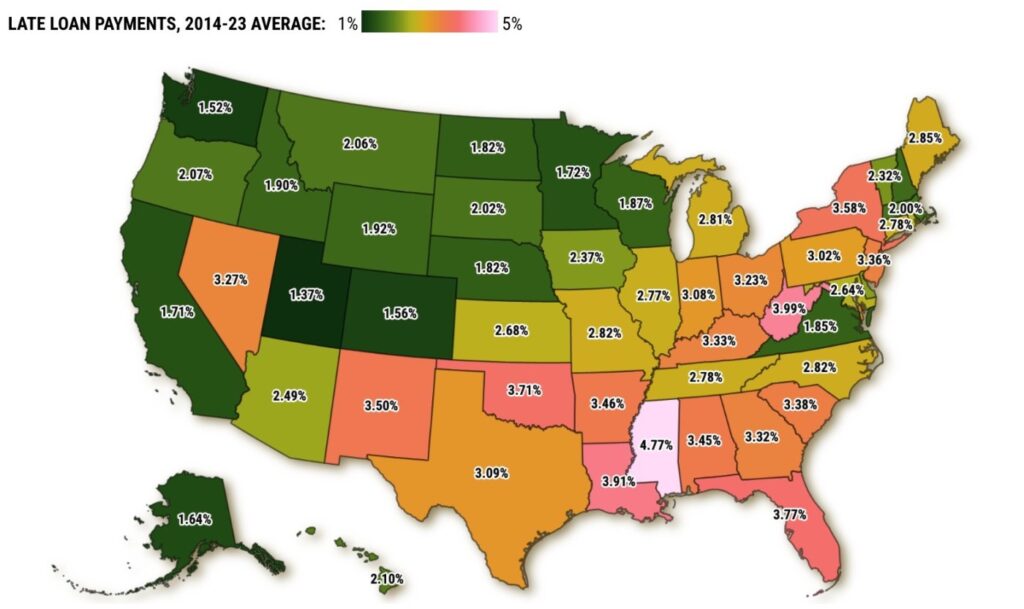
Californians have been surprisingly good at paying their bills despite all the financial hurdles of Golden State life.
That’s what I found when my trusty spreadsheet looked at a decade’s worth of consumer delinquency data from the New York Fed. These stats came from Equifax credit histories tracking which debts go unpaid – mortgages, autos, credit cards and student loans.
For all the talk about the state’s sky-high cost of living impoverishing scores of residents, Californians had the nation’s fifth-best debt payment rate among the states between 2014 and 2023.
Statewide, 1.7% of combined debt balances in those categories were 90 days or more late – well below the 2.7% delinquency rate nationally. Utah had the fewest missed payments during these 10 years – just 1.4%. Next was Washington at 1.52% and Colorado and Alaska at 1.6%.
And the worst payment patterns? They were found in Mississippi, with 4.8% of debts delinquent. Then came West Virginia at 4%, Louisiana at 3.9%, Florida at 3.8%, and Oklahoma at 3.7%. Oh, and economic rival Texas was 17th-worst at 3.1% late.
Largest debts
Don’t let the good payment history obscure the fact that Californians like to borrow. Some might argue most Golden State residents need significant loans to financially survive.
The California consumer debt load equaled $70,414 per person during the past decade in these four categories. That level of per-capita loans was 45% above the U.S. norm. Only Delaware at $86,905 and Colorado at $70,466 had more.
The smallest debts were found in West Virginia at $27,766 per person, Mississippi at $29,545, and Arkansas at $31,800. And Texas was No. 29 at $42,930 and Florida was No. 26 at $44,273.
But when it came to dollars of late debts, California ranked only 23rd highest among the states – an average $1,206 per capita over the 10 years. And that’s 7% below the U.S. norm.
Tops for tardy balances? Delaware at $2,090 per capita, New Jersey at $1,901, and Maryland at $1,818. Lows? Nebraska at $712, West Virginia at $730, and North Dakota at $758.
Also, Texas was No. 15 at $1,325 and Florida was No. 6 at $1,668.
By the slice
California bill paying is by no means consistent across the four debt categories.
Mortgages: Californians have been excellent at paying their homes loans over the past decade. Tight lending restrictions helped stop missed payments and lowered foreclosure woes. Sadly, these rules also squash many homeownership dreams.
Home-loan delinquencies statewide were only 0.7% of all balances due statewide over 10 years – the ninth-lowest rate among the states and nearly half of the 1.2% national rate.
Auto loans: Californians are just OK at making car payments, nationally speaking. The state ranked No. 27 with 3.7% of 2014-23 auto loans balances delinquent. Nationally, 4.1% of car loans were late.
Student loans: California were equally mediocre the past 10 years – ranking No. 20 with 7.4% of balance late compared to 8% nationally.
Credit cards: A California weak spot, ranking eighth-worst at 8.8% late over 10 years compared to 8.1% nationally.
Bottom line
Let’s note one caveat: This data tracks only people with credit histories and the stats are averages, which can be skewed by higher-income folks.
Still, why do Californians typically pay these bills on time?
Look at some broad economic statistics for the top 10 states for bill paying compared with trends in the 10 worst late payment states. Debts aren’t missed as much in high-salary, vibrant economies.
Per capita income is more robust in the 10 best bill-paying states in 2014-23, averaging $58,568 compared to $46,540 for the worst-payers. That’s 26% higher. And California incomes were $64,815.
And pay raises are slightly larger. Incomes rose 55% in 10 years in the best bill-paying states compared to 51% in the worst-payers. California incomes grew 67%.
Plus, states with solid bill paying had noteworthy population growth: 7.2% average increases in a decade for the top 10 compared to 5.1% for the bottom 10. California didn’t fit this mold with only 1.9% population growth.
However, job growth was roughly the same 12.4% in 10 years in the best bill-paying states compared to 12.7% in the worst-paying. Yet California was up 17.7%.
But the unemployment rates were lower: 4.1% average in bill-paying’s top 10 compared to 5.1% for the bottom 10. California was an outlier at 5.9%.
Despite numerous monetary challenges Californians face, when it comes to meeting major financial obligations more than a few can “afford” the Golden State.
Jonathan Lansner is the business columnist for the Southern California News Group. He can be reached at jlansner@scng.com
Related Articles
Recently married? Here are answers to tax questions for newlyweds
We’re halfway through 2024. It’s a good time to check your credit
In the age of digital dollars, there’s value to budgeting with cash
How generative AI is changing the mortgage process
Could a ‘body double’ help you complete money tasks?
